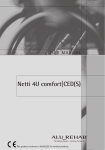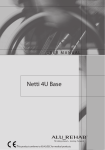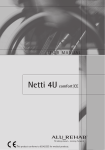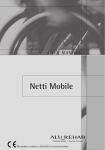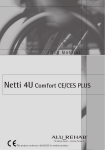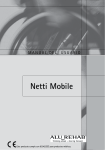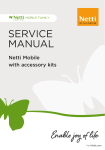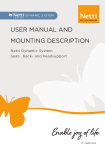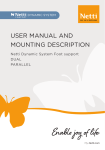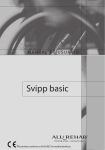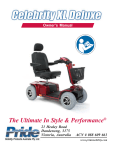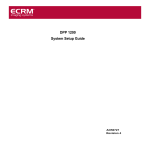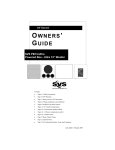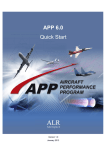Download Netti 4U Comfort | CED
Transcript
user manual Netti 4U Comfort | CED CONTENTS 1. INTRODUCTION 1.1 Quality and durability 1.2 The environment and waste disposal 1.3 About this manual 1.4 Vital measures 2. QUICK REFERENCE 3. DESCRIPTION 4. FEATURES OF NETTI 4U COMFORT CED 5. ACCESSORIES 5.1 Assembly of Hip-Belt 4 5 5 5 6 7 8 9 10 12 6. ASSEMBLING AND ADJUSTMENT 6.1 6.2 6.3 6.4 6.5 6.6 6.7 6.8 6.9 6.10 6.11 6.12 6.13 6.14 Unpacking Main wheel Front castors Seat height adjustment Back rest Seat depth adjustment at the rear Seat depth adjustment in front Anti tip Seat cushion Back rest cushion Adjusting velcro back Foot support Head support Arm support 2 Language: English Model: Netti 4U CED October 2008 12 12 13 13 14 15 15 16 16 16 17 17 19 21 6.15 6.16 6.17 6.18 Adjusting the brakes Push bow Seat angle/tilt Back rest angle 21 23 23 24 7. MANOEUVERING THE WHEELCHAIR 7.1 7.2 7.3 7.4 7.5 7.6 7.7 7.8 General about driving and parking Driving techniques - Step up Driving techniques - Step down Driving techniques - Slope Driving techniques - Up stairs Driving techniques - Down stairs Transfer Lifting the wheelchair 8. TRANSPORT 8.1 Folding for transport 8.2 Transport in a car 9. MAINTENANCE 9.1 Maintenance instructions 9.2 Cleaning and washing instructions 11. TESTS & WARRANTY 27 27 28 28 10. TROUBLESHOOTING 12. MEASURES & WEIGHT 24 24 25 25 25 26 26 27 29 30 31 Language: English Model: Netti 4U CED October 2008 3 1. INTRODUCTION Netti 4U Comfort CED is a comfort wheelchair meant for both indoor and outdoor use. It is tested and approved to EN 12183:1999. The tests were carried out by TÜV Product Service GmbH in Germany. It is also tested and approved to crash test ISO/FDIS 7176/19. In Alu Rehab we believe that wheelchairs should be chosen based on a thorough assessment focusing on the needs of the user and demands from the environment. Therefore it is important to know about the possibilities and restrictions of the wheelchair. Netti 4U Comfort CED is a wheelchair designed for users with the need for comfort and relief. The combination between the seating system and the ergonomical solutions in the frame construction, offers many possibilities for adaptation and adjustments. The wheelchair offers the possibility to vary the sitting position from activity to rest using tilt and recline functions. Max user weight: 140 kg. Specifications varies between countries. 4 Language: English Model: Netti 4U CED October 2008 1.1 Quality and durability 1.3 About this manual The Netti 4U Comfort CED wheelchair is tested at TÜV Product Service GmbH in Germany, following the European Standard EN 12183:1999. As manufacturer, Alu Rehab A.S evaluates the test to be equal to 5-6 years of normal use of the chair. The disability of the usage as well as the level of maintenance done foremost decides the durability of the wheelchair. Thus, the durability will vary depending on these two factors. In order to avoid damages while using the 1.2 The environment and waste disposal Alu Rehab and its suppliers wish to protect the environment. This means: • That we avoid using environmentally harmful substances and processes to the greatest extent possible. • That Alu Rehab’s products are ensured a long service life and a high degree of flexibility - to benefit the environment and economy. • That all packaging can be recycled. • That the wheelchair was designed to be separated into its component materials to make recycling easier. • That the wheelchair was designed with many different auxiliary functions - to improve the working environment for staff at instutions and hospitals. Netti 4U Comfort CED wheelchair, please read this manual carefully before starting to use the chair. Symbol of forbidden actions. No warranty can be claimed when ever these actions are implemented. Symbol of warning. Whenever this symbol is used, caution has to be taken. Symbol for important information. Symbol for useful tips. Symbol for tools. Anti-tip Correctly fitted, the anti-tip will secure the chair from tipping backwards. We strongly recommend use of the anti-tips. Language: English Model: Netti 4U CED October 2008 5 1.4 Vital measures Netti 4U Comfort CED is a comfort wheelchair designed for both outdoor and indoor use. It is tested and approved to EN 12183:1999. The tests were carried out by TÜV Product Service GmbH in Germany. Specifications varies between countries. Seat width: Seat height: (From floor to top seat plate using 24” main wheels in upper hole position). 46,5 cm* 35, 40, 43, 45, 50, 55 & 60 cm *By changing position of main wheels, it is possible to achieve seat height of 50 cm. whewheel Seat depth: * Back rest height: 48 cm* (From back rest cushion to front of seat plate) 42,5, 45, 47,5, 50 cm * Using back rest extender gives 60 cm ******** * ** 6 Language: English Model: Netti 4U CED October 2008 2. QUICK REFERENCE The content of this page is a summary of the whole manual. It gives a brief introduction to the use and care of the Netti 4U Comfort CED wheelchair. The quick reference is not a replacement for the manual, only a reminder/check list. • Unpack the wheelchair (Chapter 6.1) • Mount the main wheels (Chapter 6.2) • Mount the front castors (Chapter 6.3) • Put the back rest back, and mount the recline gas strut to the back rest using the locking bolt. (Chapter 6.5) • Mount the cushions (Chapter 6.9 and 6.10) • Mount the foot supports (Chapter 6.12) • Mount the head support (Chapter 6.13) • Set anti-tip in active position (Chapter 6.8) • Mount accessory. (See chapter 5 for more information. Mounting descriptions will accompany the accessory.) Drive carefully! Never stand on the foot supports due to risk of tipping forwards. Never lift the wheelchair by the foot supports or arm supports. When the chair is tilted rearwards, the anti tips and brakes should always be in use. Be sure to lock all handles properly. The anti-tips should always be used for the safety of the user. Product configuration may vary between different countries. If in doubt - contact your dealer! For troubleshooting, see chapter 10. For mounting and adjustments see chapter 6. Language: English Model: Netti 4U CED October 2008 7 3. DESCRIPTION Standard version* 1. Lock for push bow 2. Release handle 3. Push bow 4. Head support bracket 5. Angle and depth adjustment for head support 6. Head support 7. Back rest 8. Arm support with pad 9. Seati cushion 10. Angle adjustable foot support 11. Calf support bracket 12. Calf support 13. Foot plate 14. Front castors 15. Front fork 16. Brakes 17. Anti tip 18. Main wheel 19. Knee upholstery If any of these parts are missing, please contact your dealer. * Product configuration may vary between different countries. 8 Language: English Model: Netti 4U CED October 2008 4. FEATURES OF NETTI 4U COMFORT CED Accessories Standard SEAT SEAT • Trays & reading stand for trays (See chapter 5) • Hip belts (See chapter 5) • Pressure distributive cushion • Tilt -5° to +20° • Adjustable depth of 7.5 cm WHEELS WHEELS • 24” x 1” Puncture proof main wheels with quick release axle • Push rim: Oval plastic • 7” Puncture proof front castors with quick release axle • Puncture proof wheels 12”, 16” and 24” with drumbrake (See chapter 5) * Standard main wheels may vary between countries. BACK REST BACK REST • Angle: 90° to 135° • Height: 48 cm • The back rest cushion has integrated lumbar support and side support • Push bow • Back rest extender (See chapter 5) • Lumbar support and wedge (See chapter 5) • Different back cushions FOOT SUPPORT FOOT SUPPORT • Angle adjustable foot support • Height- and angle adjustable foot plates • Removable • Universal foot support ARM SUPPORT ARM SUPPORT HEAD SUPPORT HEAD SUPPORT • Hemi cushions (See chapter 5) • Height and depth adjustable • Height, depth and angle adjustable • Removable • Different head support models (See chapter 5) Language: English Model: Netti 4U CED October 2008 9 5. Accessories Belts Several variants: Hip belts with or without upholstery and with plastic lock or car lock. (See chapter 5.1 for mounting) Trays 3 models: Swing-able, lockable and standard “push on” model. Upholstery for tray Offers a soft base for the arm resting on the tray. Wedge Increases side support. Lumbar support Increases lumbar curvature. Backrest Cushions Many to choose from. Please contact your dealer. Spoke protectors For 20”, 22” and 24”. Black or transparent is optional. Foot box Upholstered Foot supports: Angle adjustable Universal Adjustable in fixed positions between 33° to 105° using an adjustment wheel. Amputation support Vital Base Integral Pelvic stabilizer. Seat Cushions Many to choose from. Please contact your dealer. 10 Upholstery for calf support bracket Reduces pressure. Language: English Model: Netti 4U CED October 2008 Head support Support C Large. Support A Side support Support B Small Side support Correction Meant for correction of bad postures in the upper trunk. Hygiene cover Protects the core of the head support. Pad for side support Correction Head cushion 40x40 cm cushion with Kospoflex filling and rubber band. Head cushion Comfort Cushion with Kospoflex filling to pull onto head rest. Hemi cushion An accommodating support for hemiplegic users. Backrest extender 12 cm extender. To be used together with 60 cm back rest cushion. Main wheels 12”, 16” and 24” with drumbrake Foot board with lock The foot support can be swung to the side like standard foot supports. Side support Stable Meant for users with decreased stability of the upper trunk. For otimal function use together with Stable cushion. Pad for side support Stable Calf pad hinged The user doesn’t have to lift the leg when mounting or dismounting the foot supports. Abduction block The block reduces abduction. Small: 80 mm width Medium: 120 mm width Large: 140 mm width Anti tip Anti tip with tramp pedal Tool set Language: English Model: Netti 4U CED October 2008 11 5.1 Assembling of hip belt Illustration 5.1.1 • Pull the belt through the hole in the hip belt bracket. 6. ASSEMBLING AND ADJUSTMENT Ill. 5.1.1 Illustration 5.1.2 • Thread the belt back through the belt 6.1 Unpacking 1. Unpack all the parts, and check that clamp. everything is there according to the packing list. 2. Mount the main wheels (Chapter 6.2) 3. Mount the front castors (Chapter 6.3) 4. Check and adjust the seat dept (Chap. 6.6) 5. Mount the backrest (Chapter 6.5) 6. Mount the seat and back cushion (Chapter 6.9 and 6.10) 7. Mount the foot supports (Chapter 6.12) Ill. 5.1.2 8. Mount the head support (Chapter 6.13) Illustration 5.1.3 9. Mount any accessories (Chapter 5). • Fix the hip belt bracket to the back rest hinge in the rearmost hole, using the Tools needed are described under each enclosed screws and nuts. chapter. Accessories described in chapter 5 is a presentation of options and will be delivered with sepearate mounting descriptions 6.2 Main wheel Ill. 5.1.3 2 pcs13 mm open-end spanner 12 To mount the main wheel remove the quick release bolt from the hub bushing, lead it through the centre of the main wheel and into the hub bushing while pressing the knob in center ( Illustration on next page) Language: English Model: Netti 4U CED October 2008 To check that the main wheel is properly attached to the hub, remove the finger from the central knob and pull at the main wheel. 6.4. Seat height adjustment If the main wheel doesn’t lock, don’t use the wheelchair but contact your dealer. • Using 24” main wheels in the upper hole, the seat height is 46.5 cm from the floor to the seating plate. • Using 24” main wheels in the next upper position, the height will measure 50 cm to the seating plate. • Using 12” and 16” main wheels the seat height is 46.5 cm from the floor to the seating plate. 6.3 Front castors To take of • Press the release button under the front fork. The seat height at the rear depends on: • Size of main wheel. • Position of main wheel. If it is required to change position of the main wheels or to change to a different size of main wheels, unfix the hub bushing including washer and nut. Remove the hub bushing and mount it in the required position. To mount • Lead the quick release axle into the bearing house. Pull the fork slightly to ensure that the fork is fully locked. 2 pcs. 24 mm open-end spanner. Language: English Model: Netti 4U CED October 2008 13 Main wheels and front castors should be mounted according to the description below. 24”main wheel 24", 16" and 12" main wheel 24" 16" 24" main wheel 12" main wheel Ill. 6.5.1. • Lock the back rest by pushing the locking bolt through the plastic bracket and gas spring locking head (Ill. 6.5.2.) When the seat height is changed ensure that the front castors are placed so that the lower frame tube is parallel with the ground. Check the position of the anti tip and readjust the brakes after mounting the main wheels or changing the main wheel position. To check that the back rest is locked, grip the push bow and press the back rest forward. If the back rest falls forward repeat the locking procedure or contact your dealer. 6.5 Backrest • To mount the gas spring, lift the push bow with one hand, and lead the gas spring locking head into the plastic bracket (Ill. 6.5.1). • Check that the hole in the locking head is parallel with the open holes in the plastic bracket. 14 Ill. 6.5.2 • The wheelchair is set to a standard seat depth, and the plastic bracket has 4 holes of which three are temporarily blocked with plastic plugs (Ill. 6.5.3). Language: English Model: Netti 4U CED October 2008 • Lock the back rest by pushing the locking bolt through the plastic bracket and the gas spring locking head. • After changing the hole position in the plastic bracket, the hole position in the back rest hinge must be changed into the parallel position. Ill. 6.5.3. • The back rest hinge has 4 holes (Ill. 6.5.4) The hole positions are in accordance with the holes in the plastic bracket. If the locking head of the gas spring is mounted in the inner hole of the plastic bracket, the back rest hinge should also be mounted in the inner hole etc. Check that the hole in the back rest hinge and the plastic bracket are mounted in parallel position. 6 mm Allen-key 6.7 Seat depth adjustment in front It is possible to adjust the seat depth with up to 10 cm in front. Do the following. • Screw out the screws in the adjustment piece (Ill. 6.7.) • Place the adjustment piece in the wanted position • Replace and tighten the screws Ill. 6.5.4. 6.6 Seat depth adjustment at the rear. • If the seat depth should be adjusted at the rear, release the locking bolt from the plastic bracket (Ill. 6.5.2.). • Find the required position for the locking head in the plastic bracket, and remove the plastic plug from this hole. Ill. 6.7 6 mm Allen-key If the user has spastic tendencies the adjustment piece should not be pulled out more than 5 cm. Language: English Model: Netti 4U CED October 2008 15 6.8 Anti tip The anti tips should be mounted according to the mounting description which is enclosed with the chair upon arrival. Use of the anti tip • Pull the anti tip out • Turn it up or down 180°. • Lock it in position Adjusting the height of the anti tip The anti tip can be adjusted in to fixed positions. The short position is for 12” & 16” main wheels and 24” in upper position. The long position is for 24” main wheels in lower position. • Unfix the screw in the adjustable extension piece as shown in picture below. • This extension piece has two holes. Place it in the required position and tighten the screw The anti tip should always be used for the safety of the user. 6.9 Seat cushion The seat cushion is attached to the seat plate with velcro. It is very important to place the cushion in the wheelchair before use. 6.10 Back rest cushion The back rest cushion is attached to the back rest with the velcro. The seat and back rest cushion covers are washable and thereby reuseable. Follow the instruction on the cushions for correct maintanance and washing of the cushions. 5 mm Allen key 16 Language: English Model: Netti 4U CED October 2008 6.11 Adjusting the velcro back • Loosen the straps and place the back rest cushion so that the user gets room for the bottom and the integrated lumbar support in correct position. • Tighten the straps so that they follow the curvature of the spine and gives a little extra support at the top of the sacrum. Mounting of foot support • Grip the foot support in the hinge point. Hold it in an angle of app. 20° to the side frame. Put it into the plastic lock attached to the extractable adjustment bar. Swing it in and push down 6.12 Foot supports Angle adjustable foot support The Angle adjustable foot support is freely adjustable in angle. It is also swingable and removeable. The foot plates are foldable and can be angled in fixed positions. Delivered with height and depth adjustable calf support Adjusting the angle • The angle of the foot support can be adjusted using the star wheel. • Loosening this star wheel enables you to adjust the foot support to the required angle. • Fix the angle by tightening the star screw. Language: English Model: Netti 4U CED October 2008 17 Locking and releasing the foot plates • The foot plates come with a locking bolt which makes the plates stronger • To lock the foot plates pull the plastic lock on the right foot plate and place the lock over the bolt on the left foot plate. • To release the foot plate pull the plastic lock and lift the right foot plate up. Adjusting the length of the foot support • Untighten the screw (A) to make the adjustment tube move • Adjust the foot support in required position and fix the screw properly. Adjusting the angle of the footplate • The foot plates can be adjusted in angle. • Untighten the screw (B) and adjust the foot plate to the required angle. Fix the screw properly 5 mm Allen key. 18 For outdoor use, there should be a clearance of 4-5 cm between the plate and the ground. Removing the foot support: • Pull the plastic lock on the foot plate rearwards, so that the pin is released, and the foot plate can be folded up. • Raise the foot support a few degrees. • Release the foot support by pulling it slightly straight up. • Swing the foot support outwards. • Lift and remove the foot support. Language: English Model: Netti 4U CED October 2008 6.13 Head support Adjusting the calf support The calf support is height and depth adjustable. To adjust height unfix the nut on the outside of the calf support bracket, find the required height and fix the nut again (Ill. A). A - Lever for depth adjustment B - Wheel for angle adjustment C - Lever for height adjustment D - Head support bracket 10 mm open-end spanner To adjust in depth, the calf pad is removed from the bracket by using an open-end spanner between the pad and the bracket. Find the required position and refix it (Ill.B) 13 mm open-end spanner Never stand on the foot supports! Never lift the wheelchair by the foot supports. • Place the squared nut in the trace of the head support bracket as shown above. • Place the head support in the head support bracket. • The height and the depth of the head support is set to the required positions and tightened. Language: English Model: Netti 4U CED October 2008 19 Adjusting the head support sideways: • The head support adapter can be moved both to the right and left, giving the possibility to accomodate special needs for head support. • Untighten the four screws holding the adapter together. • Move the adapter to the required position and fix the adapter by tightening the screws diagonally. Remember to release the levers when adjusting the head support. • The head support bracket is fixed by tightening the four screws two by two diagonally so the bracket is fixed with the same strength divided on the four screws. If the head support stand does not fit the bracket perfectly the bracket is probably fixed too tight or unevenly. Adjusting the head support in depth: • Release the locking lever on top of the vertical bar (A). • Adjust the head support and fix it in required position. After fitting the head support fix it properly by tightening the little set screw in the centre on top of the head support bracket using an Allen key. Adjusting the head support in height: • Release the locking lever on the head support adapter (C). • Adjust the head support and fix it in required position. Adjusting the head support in angle: • Release the adjustment wheel at the rear of the horizontal bar (B). • Adjust the head support and fix it in required position. 20 If the head support seems to short in height, it can be turned 180° by releasing the adjustment wheel at the rear of the horizibtal bar (B) Language: English Model: Netti 4U CED October 2008 6.14 Arm support • The arm support can be swung backwards Adjusting the height of the arm support • Untighten the screw on the arm support using a 4 mm Allen key. • Raise or lower stem • Tighten the screw When side support is mounted on the wheelchair, it will not be possible to revolve this arm support. • Press the red handle to release the arm support for to swing it backwards 6.15 Adjusting the brakes Netti 4 U Comfort CED is delivered with two diffrenet models of brakes. • The brakes are freely adjustable along the frame tube. Adjusting the depth of the arm support • Press the red knob for to adjust the depth of the arm support. Ill. 6.15.1 Language: English Model: Netti 4U CED October 2008 21 • To release the brake, pull the handle rearwards (Ill. 6.15.2). Ill.6.15.5 Ill. 6.15.2 Netti 4U brake • To activate the brake, push the handle forward (Ill 6.15.3 • For fine adjustment, loosen the upper screw on the inside of the brakes (Ill. 6.15.6) • Adjust the brake position and tighten the screws. Ill. 6.15.3 • To release the brake, pull the handle rearwards (Ill. 6.15.4). Ill. 6.15.6 5 mm Allen key Ill. 6.15.4 • To reposition the brake, loosen the two screws on the inside of the brake clamp (Ill. 6.15.5). 22 Check that the brakes are correctly adjusted by activating the brakes and be sure that the wheel- chair doesn’t move. The brakes are constructred as parking brakes and shall not be used as driving brakes Language: English Model: Netti 4U CED October 2008 Drum brake If the wheelchair is mounted with 12” or 16” main wheels, these will be equipped with drum brakes. 6.16 Push bow The push bow is handle adjustable. Ill. 6.16.1 If the brake doesn’t brake properly: To adjust the wire on one or both sides, adjust the foot screw 2-4 rounds out. Then re-check the brakes. If the wire is too loose: Adjust the foot screw all the way in. Tighten the wire by loosening the wire clamp before pulling the wire further through it. Tighten the wire clamp, and adjust the foot screw out again • Open the handle for to change the angle of the push bow (Ill. 6.16.1) Ill. 6.16.2 • Lock the handle after placing the push bow in the required position. ( Ill. 6.16.2) 6.17 Seat angle/tilt The seat angle is regulated using the release handle mounted on the push bar. The seat unit can be tilted from -5° to +20 1 pc 10mm open-end spanner. Language: English Model: Netti 4U CED October 2008 23 6.18 Back rest angle The back rest angle is regulated using the release handle mounted on the push bar. The angle can be regulated from 90° to 135° . Companion: If the user is left alone in the wheelchair, always lock the brakes and check that the anti tips are turned down. Parking: The release handles have the following label Increase the underneath support of the wheelchair by moving the chair about 10 cm rearwards making the front castors turn forward. 7.2 Driving techniques - Step upRecline Tilt Risk for tipping. Check the position of anti tip. Don’t leave a user in the wheelchair when it is tilted forward. 7. MANOEUVRING 7.1 General techniques The weight and balance of the chair influences the manoevring qualities of the wheelchair. The weight, size and sitting position of the user are also influencing factors. The position of the wheels will in addition influence the manoevring qualities. The more weight placed over the main wheels, the easier it is to manoevre. If heavy weight is placed over the front castors, the chair will be heavy to maneuvre. 24 Companions, drive up a step forwards: • Check that the anti tip is turned up. • Angle the wheelchair backwards. • Balance the chair on the mainwheels and push it forward until the front castors are on the step. • Lift the push handles while pushing the chair onto the step. Turn the anti tip downwards. Users, drive up a step backwards: This technique is only useful if the step is very low. It also depends on the clearance between the footplates and the ground. • Check that the anti tip is turned up. • Drive the chair backwards towards the step • Make a firm grip on the push rims and move the body forward while pulling. Turn the anti tip downwards. Language: English Model: Netti 4U CED October 2008 Companions, drive up a step backwards: • Check that the anti tip is turned up • Pull the chair backwards next to the step • Angle the wheelchair backwards, moving the front castors slightly up in the air. • Pull the wheelchair up the step and go backwards long enough to put down the front castors on the step. 7.4 Driving techniques - Slope - Important advise for driving down and up hill avoiding the risk of tipping. Avoid turning the wheelchair in the middle of a slope. Always drive as straight as possible. It is better to ask for assistance than taking risks. Driving uphill: 7.3 Driving techniques - Step down- Move the upper part of the body forwards in order to maintain the balance of the chair. • Check that the anti tip is turned up • Angle the wheelchair backwards, moving the front castors slightly up in the air. • Drive carefully down the step and angle the wheelchair forward putting the front castors back on the ground. Turn the anti tip downwards. Driving downhill: Companions, drive down a step forwards: Companions, drive down a step backwards: • Check that the anti tip is turned up. • Move the wheelchair backwards to the step. • Drive carefully down the step and move the wheelchair backwards on the main wheel until the front castors have come away from the step. • Put the front castors down on the ground. Turn the anti tip downwards. Move the upper part of the body backwards to maintain balance of the chair. Control the speed of the chair by clutching the push rims. Do not use the brakes. 7.5 Driving techniques - Up stairs Always ask for assistance. Never use escalators, even if assisted by a companion. With assistance, backwards. • Check that the anti tip is turned up, • Pull the wheelchair backwards to the first step of the stairs. • Angle the wheelchair backwards on the main wheels. • Pull the wheelchair slowly up the stair, one step at the time keeping the balance on the main wheel. Language: English Model: Netti 4U CED October 2008 25 • Reaching the top of the stair, pull the wheelchair backwards far enough to put the front castors safely down on the floor. Turn the anti tip downwards. If two companions are present, one person can assist lifting in the front of the frame. Do not lift the wheelchair holding onto the foot supports. Do not lift the wheelchair holding onto the arm supports. The companions should use the strength in their legs carrying the chair, avoiding unnecessary stress on the back. 7.6 Driving techniques - Down stairs Never use escalators, even if assisted by a companion. With assistance, forwards • Check that the anti tip is turned up • Drive the wheelchair forward to the first step of the stair. • Angle the wheelchair backwards on the main wheels. • Have a firm grip on the push bow, and keep the balance on the main wheel taking one step at the time • Reaching the bottom of the stair, put the front castors safely down on the floor. 26 Turn the anti tip downwards. If two companions are present, one person can assist lifting in the front of the frame. Do not lift the wheelchair holding onto the foot supports. Do not lift the wheelchair holding onto the armrests. 7.7 Transfer Techniques for transfering to/from the wheelchair should be practiced well with the persons involved. Here, we give some important advices for preparation of the chair. With or without companion - sideways. Before transfer: • The wheelchair should be placed as close as possible to the destination of the transfer. • Pull the wheelchair backwards 5-10 cm in order to make the front castors turn forward. • Lock the brakes. • Remove foot support and arm support on the side of the transfer. With or without companion – forwards. Before transfer: • The wheelchair should be placed as close as possible to the destination of the transfer. • Pull the wheelchair backwards 5-10 cm in order to make the front castors turn forward. • Lock the brakes. • Tilt chair forward Language: English Model: Netti 4U CED October 2008 8.1 Folding for transport Using a lift: Before transfer to chair: • Tilt the chair back • Remove the head support • Remove the foot supports • Open the back rest angle slightly • Replace the components when transfer is finished. 7.8 Lifting the wheelchair • The wheelchair should be lifted in the frame only and it is marked with symbol (ill. 7.8.1) where it should be lifted. Ill. 7.8.1 Ill. 7.8.2 Never lift the wheelchair with in the the push bow,. This is marked with symbol (ill.7.8.2). • Remove the head support (Chapt. 6.13) • Turn the anti tips upwards (Chapt. 6.8) • Remove the foot supports (Chapt. 6.12) • Pull out the locking bolt for the back rest, and place the backrest forward in the seat (Chapt. 6.5) • Remove the main wheels (Chapt. 6.2) • Remove the front castors (Chapt. 6.3) 8.2 Transport in car It is important to notice that correctional belt systems used in the chair are not replacing the need for a safety belt when transported in a car. If the head support is mounted correctly it is very stable but does not replace the need for an external neck support mounted in the car. The chair is marked with stickers in 4 positions, showing where to fix the straps Never lift the wheelchair in the foot supports or arm supports Never lift the wheelchair with a user in it. In front: Use hook or strap attachment. 8. TRANSPORT Netti 4U Comfort CED is tested and approved to crash test ISO/FDIS 7176/19. A 3-point belt system is recommended. This secures the user well during transport. In the pictures straps of the type Q’Straint is used. Language: English Model: Netti 4U CED October 2008 27 Frequency Check defects/damages E.g. breakage/missing parts Mount an “eye-bolt” in one of the holes in the wheel frame bracket. Hook on a hook/ carabine hook in the “eye-bolt” The angle of the straps should be 0-45° Weekly Monthly X Washing of wheelchair X Oiling of bearings* X Washing of cushions X Check anti tip function X Check brake adjustment X Check tyre wear X * As a rule of thumb, use oil on movable parts and all bearings. Alu Rehab recommends use of ordinary bicycle oil 9. MAINTENANCE 9.1 Maintenance instructions Extra parts/replacement of single parts 9.2 Cleaning and washing 1. Remove seat cushion before washing The Netti chairs are built of modules. Alu the wheelchair. Rehab carries stock of all parts and is 2. Clean cushions and covers according to ready to supply these on short notice. instructions printed on cushions. Necessary instructions for mounting will 3. Clean frame using water and a rag. follow the parts. 4. If jet water washing, avoid pointing directly towards gas springs, labels and You can order original paint from back cushion. Alu Rehab to repair scratches and 5. We recommend using soft soap. minor damages to the paint: 6. Wash the wheelchair well using clean Please contact your dealer to water to remove all the soap. order. 7. Use methylated spirit to remove any dirt eft If defects or damages occur, please contact your dealer. For small damages to the surface, original surface paint can be Check/re-adjust screws and nuts ordered from the manufacturer. at regular intervals. Language: English Model: Netti 4U CED October 2008 28 10. TROUBLESHOOTING Symptom Reason/Action Reference in manual The wheelchair is going askew • The main wheel hubs might be incorrectly mounted • One of the brakes might be too tight • The user is sitting very askew in the chair • The user might be stronger on one side than the other The wheelchair is heavy to manoeuvre • The main wheel hubs might be incorrectly mounted • Clean the front castors and forks for dirt • Too much weight over the front castors 6.4 The wheelchair is hard to turn • Check that the front castors are not fixed too hard • Clean the front castors and forks for dirt • Check that the front castors are placed in correct position 6.3 6.4 6.12 6.3 The main wheels • Clean and grease the quick release are difficult to • Adjust hub bushing further out from the frame take off and put on. 6.4 The brakes are not functioning well • Adjust the brake 6.12 The wheelchair feels ”shaky” • Check screws and adjustment points in general 6.4 Please contact your dealer for information about authorized service facilities that can give support if solution is not reached in this form. When in need of spare parts, please contact your dealer. Language: English Model: Netti 4U CED October 2008 29 11. TESTS & WARRANTY The wheelchair is tested and has been approved for usage both indoors and outdoors. The chair is CE marked. Maximum user weight: 140 kg TÜV Product Service GmbH. EN 12183: 1999. Tested and approved to crash test: ISO 7176/19. CE marking The CE mark is a proof that the chair meets the requirements of the EU directive for medical devices. Warranty Frame Five years against material and/or mistakes/ damages in manufacturing and workmanship. Back rest, armrest and foot support One year against material and/or mistakes/ damages in manufacturing or workmanship. Cushions, tires and spokes No guarantee. Damages covered by the warranty will be repaired/replaced. Please contact your dealer. If in doubt, please contact your dealer. Special adjustments/adaptations Special adaptations/adjustments are defined as all adjustments that are not included in this manual. When wheelchairs are specially adjusted/adapted by the customer, the warranty given by Alu Rehab A.S Norway will not be valid. If any uncertainty about special fitting and adaptations, please contact Alu Rehab A.S. Combinations of Netti and other products not manufactured by Alu Rehab A.S Generally in these cases, the CE mark of all the products involved will not be valid. However, Alu Rehab A.S has made agreements with some manufacturers about some combinations. For further information, please contact your dealer or Alu Rehab A.S Norway directly. 30 Language: English Model: Netti 4U CED October 2008 12. MEASURES & WEIGHT Seat width* Seat depth** 35cm 42,5-50 cm 40cm 42,5-50 cm Back rest heigh *** Total width Transport width Weight 48(60) cm 53 cm 46 cm 28,0 kg 48(60) cm 58 cm 51 cm 28,5 kg 43cm 42,5-50 cm 48(60) cm 61 cm 53 cm 29,0 kg 45cm 42.5-50 cm 48(60) cm 63 cm 54 cm 29.0 kg 50cm 42,5-50 cm 48(60) cm 68 cm 61 cm 29,5 kg 55cm 42,5-50 cm 48(60) cm 73 cm 68 cm 31,5 kg 60cm 42,5-50 cm 48(60) cm 78 cm 71 cm 32,0 kg * Measured between skirt guards. ** Measured from front of seat plate to back rest hinge without cushion. Using standard Smart back rest cushion subtract app. 3 cm. *** Measured from from seat plate to top of back rest velcro. The weight is including main wheels, front castors, foot supports and arm supports. No cushion. Max user weight is 140 kg. Dealer: Serial no.: Date supplied: Language: English Model: Netti 4U CED October 2008 31 www.bragd.no | Photo: Dag Magne Søyland/ Tony Hall | Print: Prosessen.no A u tho r i z e d d e a l e r s Bedriftsveien 23 NO-4353 Klepp Stasjon, NORWAY Tel. +47 51 78 62 20 Fax +47 51 78 62 21 E-mail: [email protected] www.alurehab.com
































